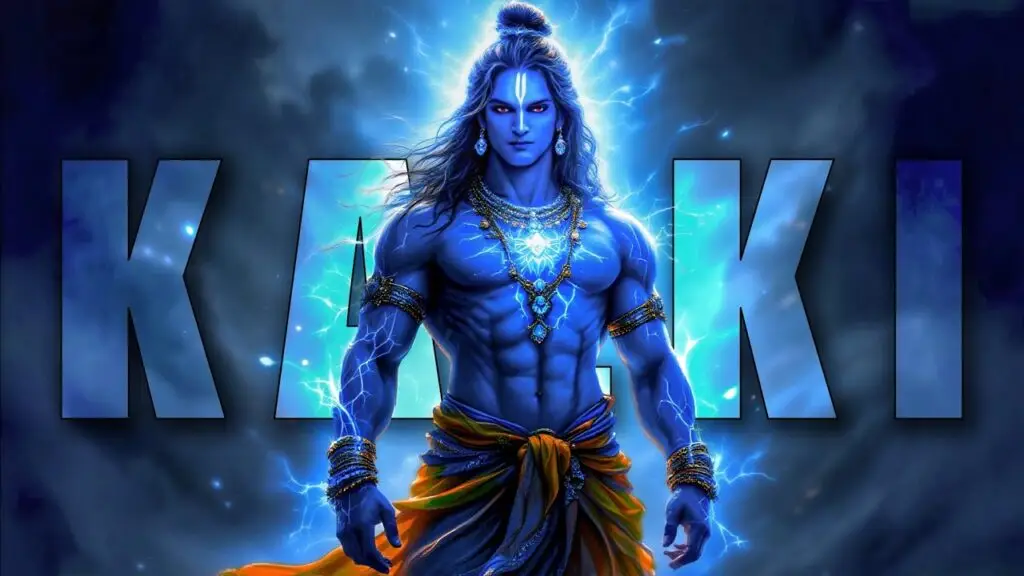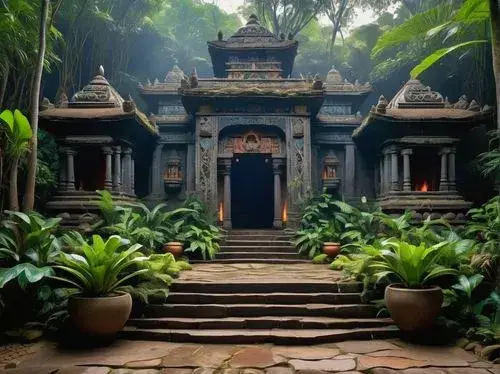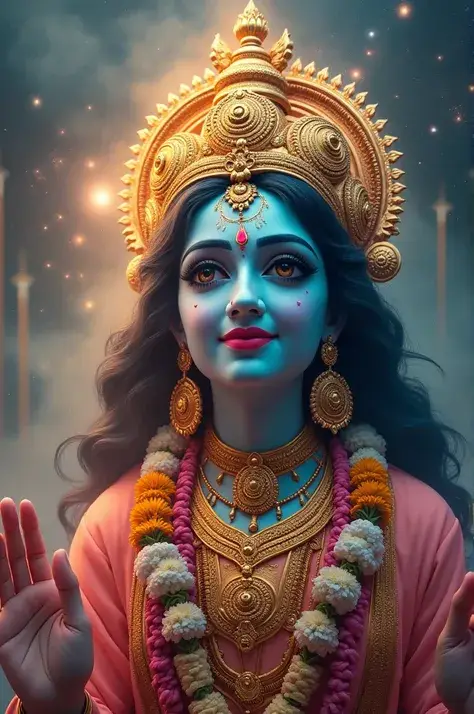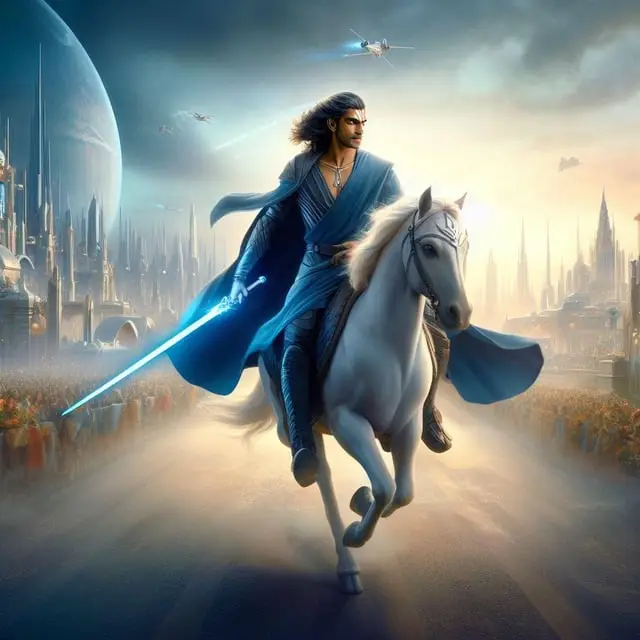The concept of Kalki Avatar, derived from Hindu mythology, refers to the prophesied tenth and final incarnation of Lord Vishnu, who is expected to appear at the end of the current age, Kali Yuga, to restore righteousness (dharma) and usher in a new era of truth, Satya Yuga. Below is a detailed exploration of Kalki Avatar, addressing the aspects you’ve mentioned (birth, age, village, married life) based on Hindu scriptures like the Kalki Purana, Vishnu Purana, Bhagavata Purana, and other relevant texts, while noting that some details remain symbolic or speculative. I’ve interpreted “Bron” as a possible typo or shorthand for “born” (birth details) and will address it accordingly. If you meant something else by “Bron,” please clarify, and I’ll adjust the response.
Who is Kalki Avatar?

Kalki is the prophesied final avatar of Lord Vishnu, one of the principal deities in Hinduism responsible for preserving cosmic order. His name, derived from the Sanskrit word kal (time) or possibly karka (white, referring to his horse), signifies the “destroyer of ignorance” or “annihilator of darkness.” Kalki is foretold to appear during the darkest phase of Kali Yuga, a period characterized by moral decay, corruption, and the decline of righteousness. His mission is to eradicate evil, defeat the demon Kali (not to be confused with Goddess Kali), and restore dharma, paving the way for the Satya Yuga, an age of truth and purity. Kalki is often depicted as a warrior riding a white horse named Devadatta, wielding a blazing sword, and accompanied by divine gifts such as a parrot named Shuka, which knows the past, present, and future.
Kalki’s narrative appears in several Hindu texts, including:
- Vishnu Purana, Bhagavata Purana, Matsya Purana, and Kalki Purana (a secondary Purana dated between 1500–1700 CE, likely composed in Bengal).
- The Mahabharata (mentioned briefly in verses 3.188.85–3.189.6).
- The Dasam Granth in Sikhism and the Kalachakra Tantra in Tibetan Buddhism, which adapt the Kalki concept to their traditions.
Some modern interpretations view Kalki symbolically as a transformative force or collective awakening rather than a literal figure, but traditional accounts describe him as a divine human incarnation.
Birth Details (“Born”)
According to Hindu scriptures, Kalki is yet to be born, and his arrival is expected at the end of Kali Yuga, which is believed to last 432,000 years. Based on traditional calculations, Kali Yuga began around 3102 BCE, meaning approximately 5,127 years have passed as of 2025 CE, leaving roughly 426,873 years until its conclusion. Thus, Kalki’s birth is projected to occur far in the future, though some texts and modern interpretations suggest symbolic or earlier manifestations.
- Date of Birth: The Kalki Purana and other texts specify that Kalki will be born on the 12th day of the waxing moon (Shukla Paksha Dvadashi) in the month of Vaishakha (April–May) or, in some sources, on the 5th day of the bright half of Shravan or Margashirsha Krishna Ashtami.
- Parents: Kalki will be born to Vishnuyasha, an eminent Brahmin, and Sumati, his wife, in a Brahmin family known for its spiritual significance.
- Siblings: Some sources mention Kalki having three elder brothers—Kavi, Prajna, and Sumantra—who will assist him in his mission.
- Divine Appearance: The Kalki Purana describes Kalki appearing in a divine four-armed form (like Vishnu) at birth, which he later transforms into a two-armed human form at the behest of Brahma to maintain secrecy. He is said to have no umbilical cord, signifying his divine origin rather than a conventional birth.
Some modern claims, such as those by the Kalki Avatar Foundation or certain online sources, assert that Kalki was born on May 2, 1985, in a Shambhala village near Mathura or Moradabad, India. These claims are not widely accepted by mainstream Hindu scholars and lack corroboration from traditional texts, which place Kalki’s arrival far in the future. For example, one source cites a book, Kalki Comes in 1985, but this is considered speculative and not aligned with the broader scriptural consensus.
Age
Since Kalki’s birth is prophesied to occur at the end of Kali Yuga, his age cannot be determined in the present context (2025 CE). Scriptures do not specify how old Kalki will be when he undertakes his mission, but they describe him as a young, divinely empowered warrior trained in warfare and Vedic knowledge from an early age. He is said to undergo rigorous training under Lord Parashurama, one of the immortal Chiranjivis and the sixth avatar of Vishnu, suggesting he will be in his prime—likely young adulthood—when he begins his conquests.
Some sources mention that Kalki’s mission will span a short but intense period, during which he will swiftly defeat evil forces and restore dharma. His divine nature implies that conventional human aging may not apply, as he is endowed with eight superhuman faculties (siddhis).
Village (Shambhala)

Kalki is prophesied to be born in the village of Shambhala (also spelled Sambhala or Sambhal), a spiritually significant location. The exact location of Shambhala is debated and often considered symbolic or mystical:
- Hindu Texts: The Vishnu Purana, Bhagavata Purana, and Kalki Purana identify Shambhala as a village in India, possibly near present-day Sambhal in Uttar Pradesh, close to Moradabad. Sambhal is home to a Kalki temple, reinforcing this association.
- Alternative Locations: Some sources suggest Shambhala could be near Mathura-Vrindavan, citing its spiritual importance and Brahmin population devoted to Krishna. Others propose it as a mythical or celestial kingdom, not a physical place.
- Buddhist Context: In the Kalachakra Tantra, Shambhala is described as a hidden kingdom north of the River Shita, possibly in Tibet or Central Asia, reflecting a Buddhist adaptation of the Kalki myth.
- Odisha Connection: Some regional traditions, particularly in Odisha, link Shambhala to Chhatia Bata in Jajpur district, though this is less common.
The Kalki Purana emphasizes Shambhala’s purity and spiritual prominence, making it an ideal birthplace for Kalki. The ambiguity of its location allows for both literal and metaphorical interpretations, with some scholars suggesting Shambhala represents a state of spiritual purity rather than a specific geographic site.
Married Life

Kalki’s married life is detailed in the Kalki Purana and other texts, which describe him marrying two princesses, symbolizing his divine and earthly connections:
- Padmavati (Padma):
- Identity: Padmavati is considered an incarnation of Goddess Lakshmi, Vishnu’s consort, born as the daughter of King Brihadratha and Queen Kaumudi of Simhala (often interpreted as Sri Lanka).
- Marriage Story: According to the Kalki Purana, Padmavati’s beauty is blessed by Shiva and Parvati, causing any man who looks at her with lust to turn into a woman. During her svayamvara (a ceremony to choose a groom), many kings and princes are transformed, but Kalki, immune to her curse due to his divine nature, marries her.
- Children: Kalki and Padmavati are said to have two sons, Jaya and Vijaya.
- Ramaa (Rama):
- Identity: Ramaa is the daughter of King Shashidhwaja and Queen Sushanta of Vallat.
- Marriage Story: In one narrative, Kalki is defeated and captured in a battle against King Shashidhwaja, who recognizes Kalki’s divine nature. To forge peace, Shashidhwaja offers Ramaa’s hand in marriage to Kalki. The marriage is celebrated with allies invited from the battlefield.
- Children: Kalki and Ramaa have two children, Meghamaala (a daughter) and Balaahaka (a son).
- Significance: Kalki’s marriages symbolize the union of divine (Lakshmi as Padmavati) and earthly (Ramaa) aspects, reinforcing his role as a bridge between the divine and human realms. His wives and children are rarely central to his mission but highlight his integration into human society.
Some sources, like a Quora post, claim that Goddess Vaishno Devi, born as Trikuta in Rameshwaram, is performing penance to marry Kalki, but this is not widely supported by mainstream Puranic texts and appears to be a regional or devotional interpretation.
Additional Details About Kalki’s Life and Mission
- Training and Mentors:
- Kalki is trained by Lord Parashurama in warfare and spiritual knowledge, mastering the 64 arts and Vedic texts.
- He worships Lord Shiva, who grants him the white horse Devadatta (a manifestation of Garuda), a jewel-encrusted sword, and the all-knowing parrot Shuka. Other deities, saints, and kings provide additional gifts like armor and knowledge.
- In some accounts, sage Yajnavalkya or Sukadeva Gosvami also guide him.
- Mission and Battles:
- Kalki’s primary mission is to defeat the demon Kali and his generals, Koka and Vikoka, who embody the vices of Kali Yuga (e.g., greed, dishonesty).
- He leads an army of Brahmins and allies, including the Chiranjivis (immortals like Ashwatthama), to conquer sinful kings and restore dharma.
- Notable battles include defeating the Buddhist monk Jina (who has strayed from dharma) and the demoness Kuthodari in the Himalayas.
- He performs the Ashwamedha sacrifice to eliminate corrupt rulers and appoints righteous kings like Devapi and Maru to rule after him.
- Divine Attributes:
- Kalki is endowed with eight superhuman faculties (siddhis), making him invincible.
- His horse, Devadatta, is described as swift and sometimes flying, symbolizing purity and speed. The sword represents divine justice.
- He uses the Mohini weapon (a divine illusion) to confuse and destroy enemies, similar to Lord Rama’s tactics in the Ramayana.
- Post-Mission: After defeating evil, Kalki returns to Shambhala to rule, divides the earth among his generals, and ascends to Vaikuntha (Vishnu’s abode). His parents, Vishnuyasha and Sumati, retire to Badrikashrama. The world transitions into Satya Yuga, where humanity is awakened to righteousness.
- Symbolic Interpretations: Some scholars, like Sri Aurobindo, suggest that Kalki’s depiction (horse, sword) is symbolic, representing a transformative force rather than a literal warrior. The “male-female” avatar concept (e.g., Sri Aurobindo and the Mother) emphasizes a holistic divine intervention. Others see Kalki as a metaphor for humanity’s potential to overcome inner and societal evils.
Bronze Age Village Marriage Life (Contextual Interpretation)
Your query includes “Bron age village marriage life,” which may refer to the marriage customs in the context of Kalki’s village (Shambhala) or the broader setting of Kali Yuga’s end, often depicted with archaic imagery resembling earlier historical periods like the Bronze Age. Since the Bronze Age (circa 3300–1200 BCE) predates Kali Yuga’s start (3102 BCE), I’ll assume you’re asking about marriage life in the simple, spiritual village setting of Shambhala as described in the Kalki narrative, which evokes a timeless, idealized rural life. If you meant something specific by “Bron,” please clarify.
- Shambhala’s Social Context: Shambhala is described as a serene, spiritually rich village inhabited by Brahmins devoted to Vedic practices. Marriage in such a setting would likely follow traditional Vedic customs, emphasizing dharma, family lineage, and spiritual compatibility.
- Vedic Marriage Practices:
- Marriages were typically arranged, with the bride and groom matched based on caste (Brahmin in Shambhala’s case), horoscopes, and family status.
- Ceremonies involved Vedic rituals like the saptapadi (seven steps around the fire), symbolizing mutual commitment, and were conducted with mantras and offerings to deities.
- The wife was considered a partner in dharma, supporting her husband’s spiritual and social duties. Women in Vedic society often had roles in household rituals and education, especially in Brahmin families like Vishnuyasha’s.
- Kalki’s Marriages as a Model: Kalki’s marriages to Padmavati and Ramaa reflect divine and diplomatic unions, blending spiritual symbolism (Lakshmi’s incarnation) with earthly alliances (peace treaty with Vallat). These marriages suggest a balance of divine purpose and societal harmony, typical of idealized Vedic unions.
- Kali Yuga’s Decline: The Bhagavata Purana notes that in Kali Yuga, marriages become driven by superficial attraction and materialism, with family ties weakening. Shambhala, however, is depicted as an exception, preserving Vedic purity, so its marriage practices would likely resist these degradations.
If you were referring to Bronze Age marriage practices specifically (e.g., in ancient India or elsewhere), they varied widely:
- In ancient India (Indus Valley or Vedic culture), marriages were patriarchal, often arranged, and tied to social structures like caste or tribe. Dowries, rituals, and clan alliances were common.
- Without specific details about “Bron,” I can’t pinpoint a particular culture or region. Please provide more context (e.g., a specific Bronze Age society) for a deeper dive.
Notes on Sources and Claims
- Scriptural Sources: The Kalki Purana, Vishnu Purana, and Bhagavata Purana are primary sources for Kalki’s story, but the Kalki Purana’s later composition (1500–1700 CE) suggests it incorporates regional and historical influences, such as Bengal’s Mughal context.
- Modern Claims: Some groups, like the Kalki Avatar Foundation or individuals like Riaz Ahmed Gohar Shahi, claim Kalki has already appeared (e.g., in 1985). These are not supported by mainstream Hindu scholarship, which places Kalki’s arrival at Kali Yuga’s end. Similarly, Nostradamus’s predictions (e.g., an “Immortal Ruler” by 2022–2025) are speculative and not part of traditional Hindu narratives.
- X Post Caution: A post on X claims Kalki will be born in Sambhal, UP, trained by Parashurama, which aligns with Puranic accounts, but such posts are not authoritative and reflect individual beliefs.
Summary
- Who: Kalki is the tenth avatar of Vishnu, a divine warrior to end Kali Yuga and restore Satya Yuga.
- Born: Prophesied to be born in Shambhala to Vishnuyasha and Sumati on the 12th day of Vaishakha’s waxing moon, far in the future (circa 426,873 years from now).
- Age: Likely a young adult during his mission, endowed with divine powers, making age less relevant.
- Village: Shambhala, possibly near Sambhal, UP, or a symbolic spiritual realm.
- Married Life: Marries Padmavati (Lakshmi’s incarnation) and Ramaa, with four children (Jaya, Vijaya, Meghamaala, Balaahaka), symbolizing divine and earthly unions.
- Bronze Age Village Marriage Life: Shambhala’s marriage practices likely follow Vedic traditions, emphasizing dharma and ritual, contrasting with Kali Yuga’s degraded norms.
If you meant something specific by “Bron” or want more details on a particular aspect (e.g., battles, symbolism, or a specific cultural context for marriage), please let me know, and I’ll provide a tailored response. For further information on Kalki or related topics, you can explore texts like the Kalki Purana or visit sites like https://x.ai/grok for general inquiries.

